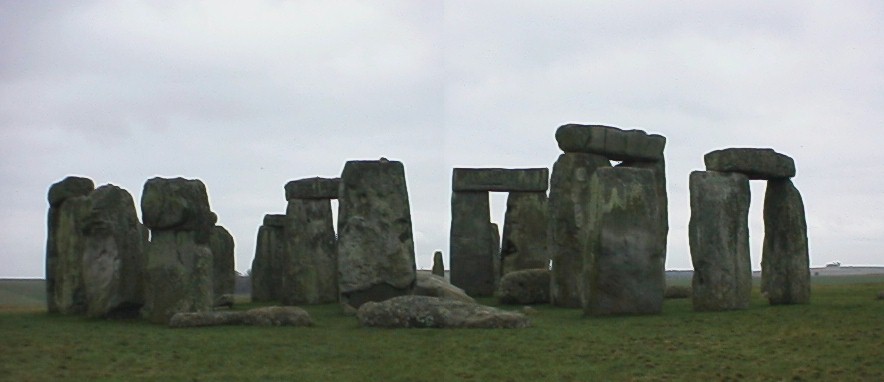
Around the World in 1998-1999; London England
Note; this post is recreated from the original wired2theworld website post with the dates below. The old posts were reformatted for the 20th anniversary of wired2theworld. As much as possible, the content is unchanged and unedited from the original, only some formatting, spelling, and link errors have been corrected.

David’s Diary:
January 29, 1999
BKK-Singapore-London
US$1= .6 pound (BP)
That has to be one of the longest flights I have ever taken! We have been on an airplane for over 14 hours, nonstop, from Singapore to London. And, we almost didn’t make it out of Bangkok!
Let me explain: We had been told on several occasions that we could not book a one-way ticket to Europe from Thailand, without having a return ticket, or onward ticket to our home country. Time and time again this little regulation would pop up on a travel agent’s computer screen and we would get nervous. We were not ready to buy that ticket and had no intention of doing so from Bangkok. We even called some of the airlines, which told us that because we were American, they might let us on but they could not guarantee it, as it had more to do with the whim of the agent at the airport that day.
On top of that, we were told that we would have the ‘onward ticket’ verified not only upon our departure from Bangkok but also upon arrival and that we ran the risk of being shipped back to Bangkok at our own expense. Unbelievable! Finally, we discovered an agent who was not scared of her computer terminal, who issued us the ticket and told us not to worry. But, at the airport, when asked, we replied simply “no, we are going to travel more, and buy our tickets in Europe.” I began to sweat, however, when the supervisor called the agent, and had some serious discussion, with much suspicious looking at us, then our passports, then at us again. Finally, it was deemed okay to let us board, and I began to breathe, slowly, as my heart rate fell back below 200 beats per second. We were off to Singapore!
The Singapore airport, where we spent a comfortable 2 and 1/2 hour layover, is far and away the greatest airport on the planet, and possibly in the entire universe. It is calm, clean, and quiet. Every service imaginable is right there at arms length, no 1500 metre walks like in Bangkok. There are signs telling you how many minutes it will take for you walk to your gate, by number. Best of all, there are countless free desks for laptop usage! Each laptop table has a power point and a telephone jack from which you can make as many local calls as you like, for free! Because iPass has a number for Singapore, we were in business. We whipped out the Libretto, tested the phone line, reversed the polarity on the connection (because we’re high tech and we do that sort of thing whenever we need to ‘get wired to the world’), and badda bing, connected at 44000baud, thanks to our super slim V.90 56k PCMCIA modem. If only the rest of the world had that kind of infrastructure, we would have less stress.
Cut to London, Heathrow, where we are uneventfully allowed into the country without the slightest hint of ‘onward tickets’. In grand contrast with Singapore, Heathrow is a labyrinth of ill-conceived shops and unhelpful people at overpriced services that really can’t help you, and would rather be talking to someone else. We spent far too much time trying to sort out which tunnel under the airport took us to the proper tube station, and the cheap hotel reservation desk, which is over a kilometer underground from the airport terminal main accommodation service- the one with the annoying people at the desk. And, the underground passages are totally confusing, half under construction, very long, and utterly annoying to this tired traveler. Thank you very much. I feel the need for a pint coming on, and maybe some fish and chips, and proper sleep. Then, perhaps, I will feel more human.
Kristina’s Journal:
January 29-February 1, 1999
London
I cannot believe how unreasonably expensive everything is here. Especially accommodations. And we’re not talking luxury or frills here either. Even a bare-bones, sex-segregated dorm bed in a hostel is 14-17 BP a night per person! A double room in the YHA hostel is 22 BP a night per person including breakfast. At Heathrow Airport, we went to an accommodations reservations desk and they laughed at us when we said we wanted a room for 35-40 BP a night. Finally, after calling about a dozen hostels (most of which were full) or B and B’s (most of which were over 50 BP a night) we made our way down to the “tube” station below where there was another accommodations desk that found us a room for 40 BP a night. Keep in mind that this is almost US$60 for a room with the toilet and shower down the hall and bad beds! Thankfully, the room turned out to be a triple, so it had a bit of extra space. Since it was in the Russel Square neighborhood, near the British Museum, we decided to stay there for the weekend and get our bearings while looking for a campervan.
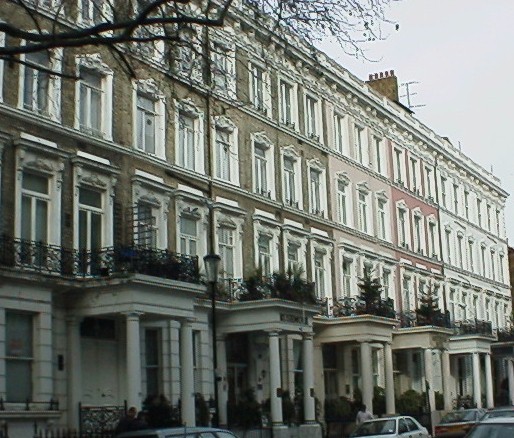
The next day we went to an area called Earl’s Court, where, we had read, were many travel agents offering cheap, last-minute deals all over the world. We wanted to see if we could find any trips to Africa, or Morocco, or Egypt, and therefore delay buying a car for a week or so. We did indeed find good deals to Egypt, but they were not really what we wanted. They all focused on the Luxor region, which has its fair share of interesting sights but is not anywhere near the pyramids which are in Cairo. Why go to Egypt if we can’t see the pyramids, right?
At this point we decided we were going to stay in Europe, so we’d better start looking for a vehicle. We also decided that we liked the Earl’s Court area better for our needs; it has cheaper ethnic food, easy internet access places (our iPass was not working in London!), laundromats, and lots of cheap, but nice hotels. So, after a bit of wandering, we found a decent little hotel, the Oliver Plaza (33, Trebovir Rd. 0171-373 7138), where, if we stayed three days, we could have a tiny room with TV, phone, our own bathroom, and breakfast, all for less than the other place (but still pricey at 36 BP a night). Sold! Just to make sure, however, we went to check out the local YHA hostel and a dorm bed would have cost us 18 BP each. Ouch.
Somewhere along we way, we managed to go to the British Museum, which, ever since I studied Ancient Greek Art History I have been dying to see. I’ve been to the Parthenon in Greece, but so much was taken from there in the 1800s and brought back to England that I felt like my view was not complete until I saw the collection in the British Museum.
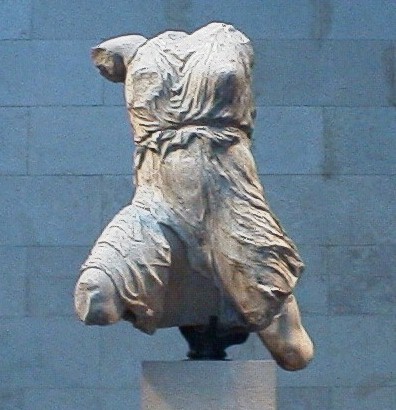
These are now sometimes referred to as the “Elgin Marbles” after Lord Elgin who brought them back from Greece in the late 1800s. The sculptures are what remains from the “frieze” of the Parthenon, which is the top portion of the temple that sits atop the Acropolis in Athens Greece. There is an ongoing debate between England and Greece as to whether or not they should be returned. Needless to say, the Greeks want their marbles back! I must say that the sculptures are truly breathtaking, and I was almost moved to tears by their beauty. It was a highlight for me to finally see these figures that I studied and wrote papers about all those years ago. Another thing to note about the museums in London is that most are free, unlike the other “tourist” sites like the Tower of London.


After deciding to stay in Europe, we started looking into buying a campervan. We knew that this was going to be difficult, especially given that most vehicles are right-hand drive, but also because it is winter, and there aren’t too many for sale. We looked in the local papers, but there weren’t too many advertised, so we went out to check a local used-van lot. Here we found a few options, including a 1973 VW campervan with left-hand drive, for 1800 BP with a 50% buy-back. But, this would mean that we would have to drive the van back to London before we left, taking it across the Channel twice. Also, it wasn’t in the best of condition and seemed fairly damp inside. Anything newer or nicer was upwards of 2500 BP and most were in the 4000-8000 range. After that, we called quite a few other listings but finally decided to wait until we got to Holland, where we had been told that buying a vehicle in Amsterdam would be just as easy.
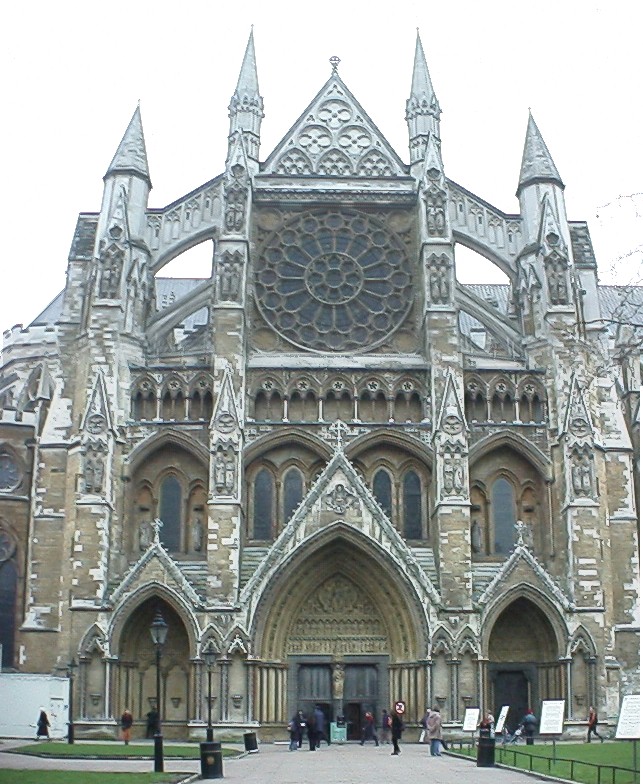
Another day we went to see Westminster Abbey, where we used our student ID cards for the first time (the ISIC cards we bought on the street in Bangkok) and they paid for themselves. Unlike most of Asia, it seems that many more admission charging sites in Europe offer student discounts. Anyway, Westminster Abbey was beautiful. Not only is it a stunning church, but it holds the tombs of Chaucer, Shakespeare (although just a monument), and Queen Elizabeth the 1st among hundreds of others. The building was founded 10th century and since then, all royal coronations, weddings, and funerals have been held there. This is the church that we all saw on TV when Charles and Diana got married.
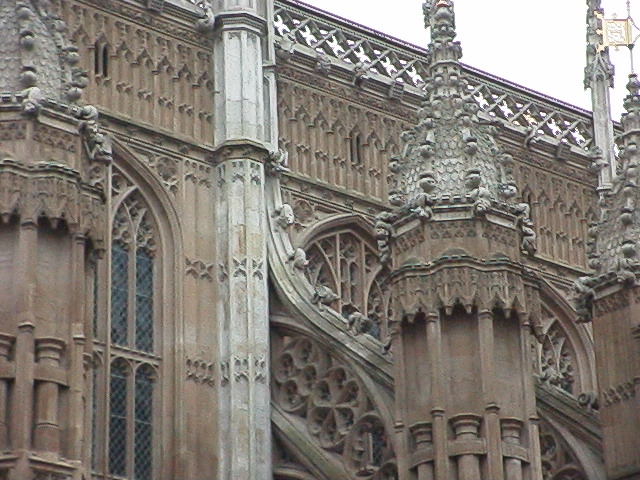
Across the street is the House of Commons, which David will describe below. It is important to note though, that it contains the infamous “Big Ben”, which is actually the bell inside the clock tower, not the tower itself. The building sits alongside the Thames river and is so large and Gothic, that we assume it was a Cathedral until we learned that that was where the House of Commons does their business.
David’s Diary:
February 1, 1999
Uncommon ground…
Would the Right Honorable Gentleman in the bench across the aisle kindly Piss Off! We went from the hallowed halls of Westminster Abbey to the hallowed pit of governance in action. One of the activities that a person can undertake for free in London is a visit the House of Commons, which is part of Parliament and, like our Senate and House of Representatives at home, goes to work every day (ahem) to do the nation’s business.
We stood in line outside of the Houses of Parliament for nearly an hour until they began to let people in. There are only one hundred free seats for the public to sit in and observe, so it is wise to get there early. The first hundred people are seated, and the rest have to wait until seats become available. The only problem with that is that anybody can stay as long as they want if they choose to, once they are in. We were numbers 101 and 102 in line.
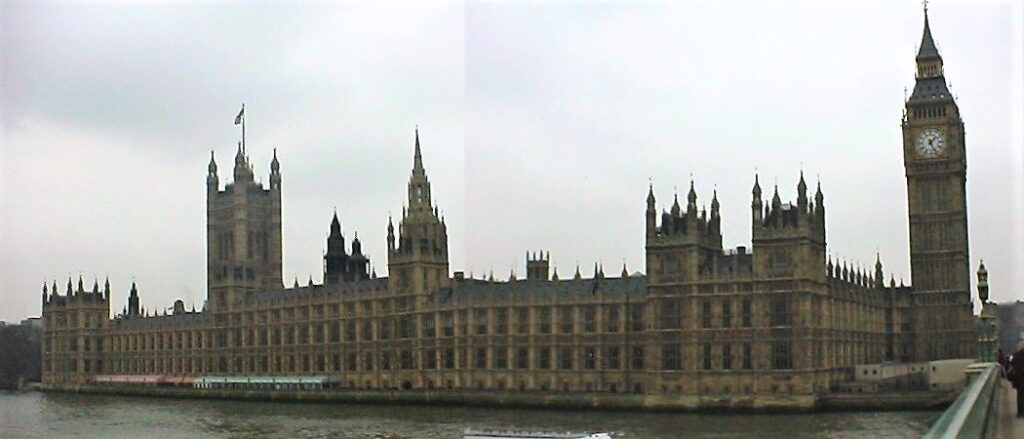
Step one involves the traditional security check, x-ray, metal detector, etc. Just like the airport. Then, you are escorted into the waiting room for the Strangers Gallery, which is a comfortable gothic antechamber with high arched ceilings and stained glass windows. It looks like a chapel at first, but a close inspection of the painted scenes, crests, and busts that surround you reveals them to be political in nature. This entire church-like building is, after all, a shrine to a great political system with a long history.
Those seated on the benches of the waiting room were duly given their ticket, and a disclaimer to sign. You must promise to remain quiet and not disrupt the proceedings, under pain of death and or imprisonment- or maybe a fat fine- and you must put it in writing. Then, in groups of ten, we were escorted to the gallery cloakroom, where all cameras, tape recorders, purses, etc. are confiscated and checked into a locker, and each person is searched by hand- actually patted down- by the special house guards. Finally, we were ushered into the Strangers Gallery and led to our seats. We were given front row seats, the first two to have been vacated by others. Down on the floor of this great theatre was the House of Commons in action.
The most interesting difference between the British government and the American government is that the Brits are interesting to watch. In contrast to Cspan and the endless droning of self-serving banalities and metaphoric insults, the members of The House of Commons, while eminently respectful to each other, doesn’t mince words.
On the left side of the room was the majority government, and the opposition party sits across the room, allowing the casual observer to know from where the comments ae coming, but also creating an environment not unlike a sporting match of some kind. In the center, facing both parties, is ‘Madam Speaker’, who is like the umpire, as she calls upon the house members in order to give them the floor. They tended to speak in turn, usually in the form of a statement or question by the ruling party, followed by a response or a question from the opposition. What fascinated me more than anything was that they were always on the subject at hand. Unlike House and Senate debates at home, where each member has five minutes to address a topic, but they use four and a half to address some personal agenda.
The real beauty of the Brits way of getting the job done was their polite tete a tete. After addressing each other as the honorable, or right honorable, such and such, they would not couch their displeasure in double entendre or subtle hints at condemnation. They came right out and boldly said whatever they truly felt, in less than diplomatic fashion at times, but always with respect. Contributing to the football match atmosphere, whenever somebody said something that was either ridiculous, or overwhelmingly supported, the politicians would either jeer loudly, or cry out ‘hear hear’ ‘yea yea’ in chorus. At first, it seemed very adolescent, but after a while, I realized that they probably go home and enjoy their home lives much much more than do our politicians, who end the day with all kinds of unexpressed emotions.
We missed the Prime Minister by two days, to our disappointment, but saw the Foreign minister, Robin Cook, instead. The agenda item was no less than the British Armed Forces level of commitment in the Kosovo conflict. They were discussing whether or not there would be ground forces involved, to what extent the need for a long term deployment of personnel would be required, etc. Amazingly, a great deal was resolved and accomplished in a reasonably short period of time. In contrast, the second issue, whether or not there would be a vote to revoke the hereditary peerage of the House of Lords, was a circus, especially from the opposition. There were jeers, rude noises, groups of people laughing, and general disorder all around. The means for interruption, a request that the person speaking ‘give way’, while quite polite, was usually followed by an eloquent ‘flaming’ of whatever point the speaker was making.
It was quite a good show, and we stayed for almost two hours. Finally, we gave way to those who were waiting patiently in the fabulous antechamber, and were on our way. I highly recommend this experience to anyone visiting London, especially because it is free, but primarily because it is an incredibly interesting and entertaining experience in the theatre of the ‘real’. This is how major governments operate. Well, this one, at any rate.
One tip- find out when they are seating, morning or afternoon, and get in line at least one half an hour early. There is a schedule posted by the door to the entrance, across from Westminster Abbey, that tells when they are meeting and which special ministers (Tony Blair, for ex.) are visiting on which days.
Kristina’s Journal:
February 2, 1999
English Cuisine? What English Cuisine?
Well, actually, it’s not all that bad. We did have some good food while we were in London. Nothing fancy however, just some good pub grub and some good ethnic food.
While we were still in the Russell Square area, we ate in a pub called The Queen’s Larder, on the southeast corner of Queen Square, west of Russell square. They serve enormous pies, which are traditional pub food. These pies are usually meat-filled, topped with a pastry crust, and here, were served with potatoes and vegetables on the side for only BP 4.95. This is a cozy little pub that dates back to the 1700’s and has a (thankfully) smoke-free tiny dining room upstairs.
In the Earl’s Court area there are lots of small restaurants to choose from, including Indian, Vietnamese, and Greek. While there, we ate twice at a small Greek restaurant at the Brompton end of Earl’s Court Road (near the YHA), which simply had a sign out front that said Mediterranean Food. There, we had excellent shwarma in pita with tzatziki and humus.
One night we had Fish and Chips and all I can say is, be prepared for a lot of food! One order of fish and chips would have been enough food for the both of us! But it was good, with lots of vinegar and salt, although a bit greasy.
We had been told, in London, you must eat Indian food. So we did. In the Earl’s Court area, we ate at a restaurant called Masala. Nothing fancy, eat-in or take-away, but it was very good and filled our craving for naan bread and raita.
Faced with a plethora of choices for fantastic sights to see in London, we were limited only by our wallet, as most of the sites have a hefty entrance fee (only the museums are free). So, we chose the Tower of London as our sight of the day. Initially, I was unaware of what exactly the tower was, picturing on the famous Tower bridge. I was pleasantly surprised.
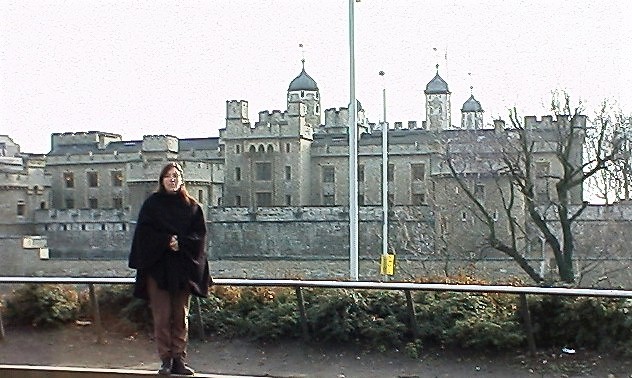
We arrived at the Tower gate, paid our student-discounted entrance fee, and found ourselves just in time for a departing tour of this walled city within the City of London. These free tours are given every hour by a residing Yeoman Warder. The Yeomen Warders are the Guards of the Monarchy and go back 700 years. They are commonly called “Beefeaters” because in the fifteenth century they were paid in beef by the King. The Yeoman Warders of the Tower actually live within the castle walls, in apartments built into the Ramparts. These men must be British retired military with at least 23 years of service and a retiring rank sergeant major or above. Our guide had been a Warder for the last 14 years and we soon set off on a 40-minute tour around the castle grounds.

The castle is famous for its many noted inhabitants including Henry the Eighth and his short-lived wife, Anne Bolyn. Turns out that Anne was the only one to pass through the Gates twice, once to her coronation and once to her execution. He explained to us how part of the Warder’s job was to lock up the Castle at night, and how they’ve never missed a night in the last 700 years. They still do it today, including a password that is still changed nightly (which, he said, could be a bother if one went to the pub, and forgot the password one the way home!).
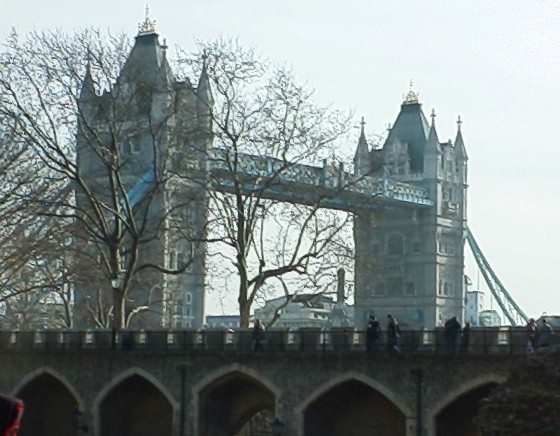
Inside the castle walls are not only the royal residence from the middle ages to the renaissance, but an armory, a separate church, and a museum containing the crests of all Kings and Queens from the 10th century on up, and the famous Crown Jewels. The Yeoman brought us into the church and told us how it was still considered a Royal Chapel and property of the Queen and it is the parish church of the 140 residents of the Tower. Because he lives there, the Yeoman’s grandchildren were baptized in the church, and therefore now have the legal right to be married in any Royal church later on in life.
The crown jewels were beautiful, though more limited than I expected. Still, there were historical scepters, crowns, and jewel-encrusted royal robes. Oh yeah, and some of the biggest diamonds in the world…

There are dozens of Black Ravens that “guard” the Tower of London and its grounds. In the old days they were used as refuse control, eating garbage. Once their population get so large, people wanted to start eliminating, but legend says that they were protected by King Charles the 2nd in 15th century. And if they all ever leave, the Tower will crumble. There are six pairs that are kept by one of the Warders, and all are descendants of the ancient, protected birds. As we walked around the grounds ourselves we discovered that they speak! One of them surprised the hell out of me and said clear as day, “Good Morning”, to me as I stood near him trying to get his photo!
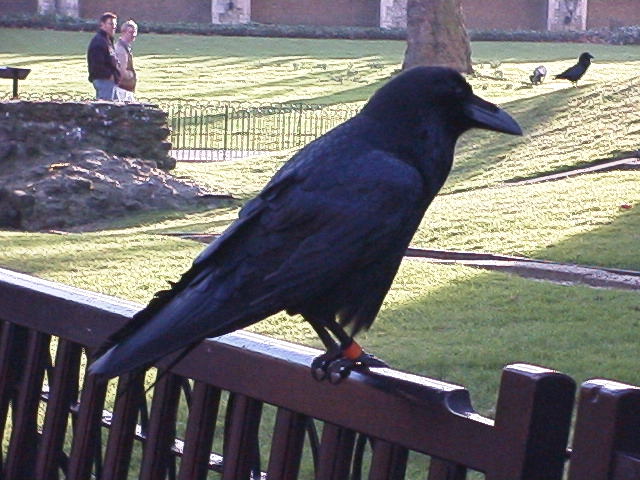
David’s Diary:
February 3, 1999 The Truth Is Out There…
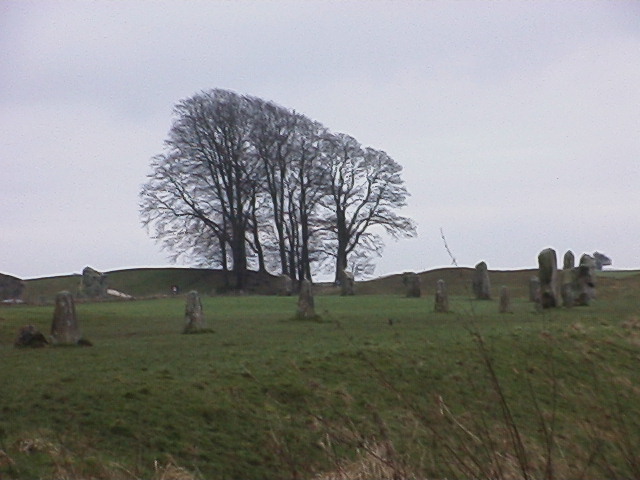
I am now a believer. There are other forces at work on the planet that we don’t know about anymore. We went on a little tour bus around the countryside near London and visited Salisbury, Stonehenge, and Avebury today, and until the last stop, it was honestly nothing more than a good tour.
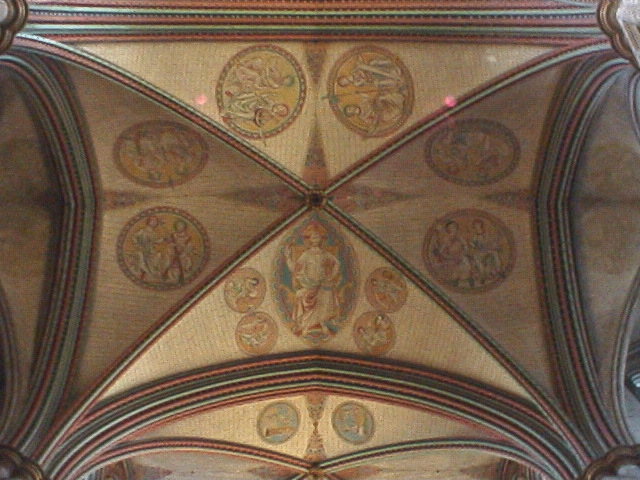
We saw the cathedral in Salisbury and walked around the town some, we saw some nearby ruins, and hit the pub for Shepherds Pie and Tanglefoot ale for lunch. Stonehenge is magnificent, but you can’t walk through it anymore, and you have to pay admission to get around the barbed wire fence, just to walk around a rope from 10 to 25 yards away. There is free audio companionship from the hand-held ‘guide-o-matic’, but K and I both got bored with it pretty fast (not like the one at Versailles, which was excellent). It was bitter cold and forebodingly gray on the near hills, which actually helped the mood a little. There is a coffee-bar/ snack kiosk, where a single hot chocolate cost about 3$. A lot of this seems to detract from the experience, while undeniably protecting and preserving the site. Don’t get me wrong here, it is still one of the coolest things on the planet, however, it has become less accessible due to the need to preserve it. It used to be that one could get a hammer from a nearby shop and use it to chip off a little piece of Stonehenge for your collection. This strikes me as totally irresponsible as well as disrespectful.
Admittedly, Kristina was expecting a much larger fence and more restricted access from the site. She actually believed that visitors would have to remain outside a barbed wire or chain link fence! Fortunately, that was not the case. It is a world heritage site, after all, and its preservation has been pursued in the interest of ongoing tourism. Druids are allowed unrestricted access to the site on key days, such as the Soltice, for which purposes the stones were put there in the first place.
Most amazing, however, is that the construction of the henge, and all of the planning and engineering required to make its design function as a calendar, was far ahead of its time, and exceedingly complex. Like the pyramids, giant stones were brought from great distances, as there are no such stones in the region itself. Geologists have determined that they came from Wales, in the only region where such stone is found. Additionally, divers have uncovered many of these stones at the bottom of the river between the two, suggesting that they were moved by boat and that many didn’t make it all the way there. The stones that lay across the top of the circle are held in place by a series of tab in slot joints, much like a rabbet joint in woodworking. I was glad, again, for the weather, because we were able to see Stonehenge without throngs of other tourists around us, and take pictures that don’t have random humans strewn about them.
Avebury. A little ways from Stonehenge, along the St. Michael’s ley line (I think St. Michael, not sure). This is a little, one-street town with charm and legitimate character. Surrounding the town is an ancient circle of really big stones of the same type that are in the outer rings of Stonehenge. At 90″ angles, corresponding with the poles, are two gateway stones. Only two of the gates remain on the circle, and many of the stones that formed the ring have been long since removed for one reason or another.
Our guide handed each of us (11 people in all) a pair of dowsing rods. A dowsing rod is nothing more than a metal rod, bent at 90″, with a loose wooden handle around the short side of the rod, allowing the long side to move back and forth freely. Hold two dowsing rods, our guide told us on one side of the stone gateway, with the needles facing forwards, and walk through the gate. As we did so one by one, the tips of each individual’s pair of rods would swing in, until they were almost facing each other. “It happens every time,” our guide says, grinning. We went next to the second set of gate stones, that led through the main ring (1.2k across, by the way), and tried the same trick. This time, the rods swung out and around until they were facing me. People from the southern hemisphere have the reverse action, the rods spin inwards and face the person holding them.
I tried this several times, due in part to my ongoing skepticism, but with the same results every time. It worked without fail every time I tried it. I was forced to accept the possibility that there were other forces at work. According to our guide, there had been several examinations of the magnetic properties of the stones, revealing that they were not concealing any heavy metals or magnetic ores. The experience defied all logic. I don’t know very much about the study of ley lines and ancient mysticism, but I was moved to the point that I will absolutely pick up a book about it.
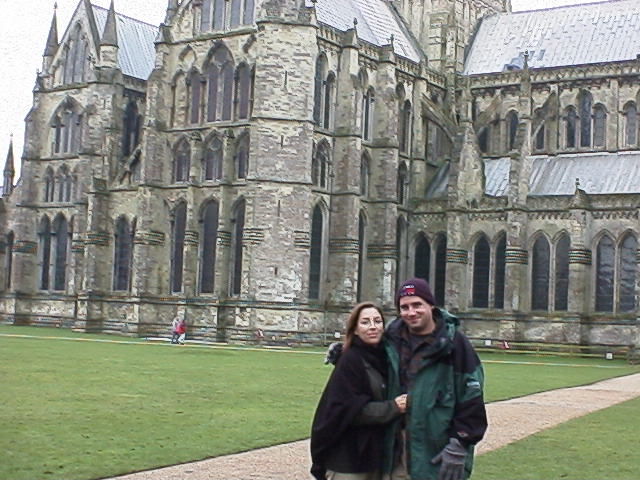
Kristina’s Journal:
February 4, 1999 Salisbury and Stonehenge
Because we decided to limit our time in England due to the high cost of living and no transportation, we decided to take a tour that would encompass some of the main sights to see outside of London. After investigating a number of tours, we decided to go with one of the ones given by Astral Travels, (0700 0781 016). We discovered their brochure in the YHA, complete with 10 BP off voucher, for a tour that is ordinarily 44 BP per person, inc. lunch in a local pub and all entrance fees. This tour is called “Stones and Bones” and goes to Salisbury, Stonehenge, Old Sarum Fort, and Avebury. They have a maximum 15 people on small bus which seemed better than a giant tour bus to us. They also do inner circle stonehenge tour once a month which is 15 BP extra.

Our first stop was the town of Salisbury and the Salisbury Cathedral, built 1220-1258, which is incredibly fast. It was absolutely stunning, with tallest spire in England, that was added in 14th century. The spire has too much weight to it and rests on only 4 feet of foundation to support it. In the 17th century, they discovered it was leaning, but corrected it and it still stands today. One of the things that fascinated me the most was the painted arches and ceilings, which are common of the era, but so few remain today. The docents said that the Victorians were great restorationists and had restored many of the old paintings. The cathedral also contains the earliest working clock in the world, from 1386.
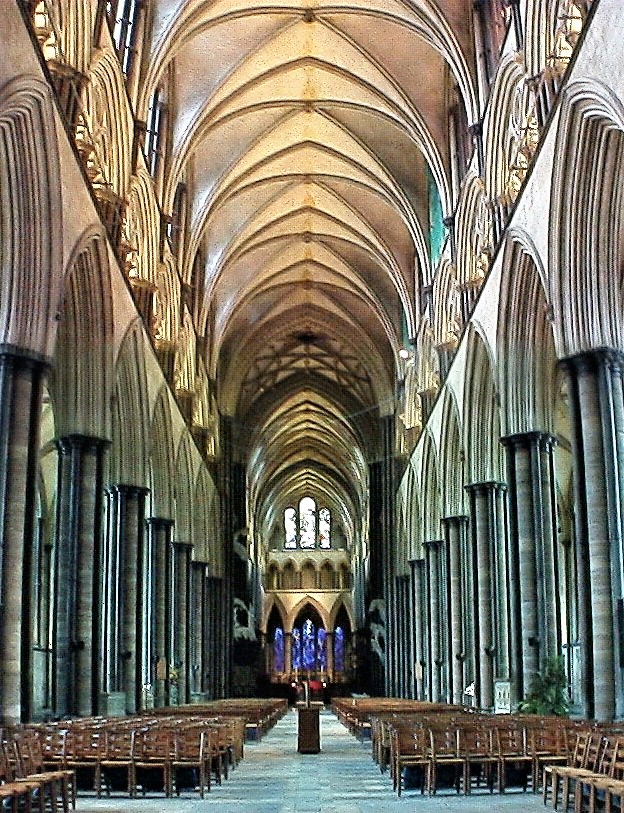
Along with the cathedral are beautiful and serene cloisters surrounding a huge ancient tree. There is also a chapel that holds one of the four remaining copies of the Magna Carta. This was the agreement between King John and his Barons in 1215, written in Latin on vellum, that states that no free man may be imprisoned or prosecuted without fair trial before his equals. This guarantee was incorporated into Constitution of the United States. The octagonal chapel also has a medieval frieze bordering its top edge depicting scenes from Genesis to Exodus in order.
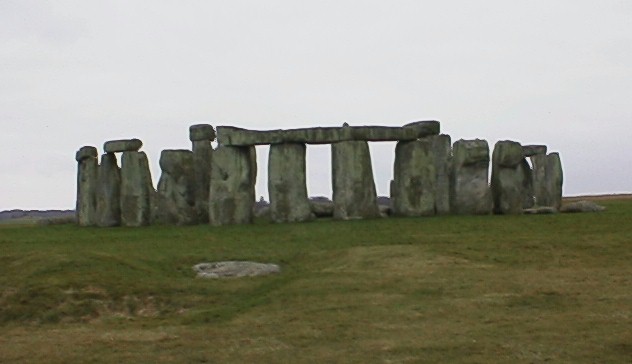
Stonehenge was not what I expected, actually, it was better. I had heard that it was now behind a giant chain link fence, and you really couldn’t get close to the stones. But, if you pay admission, you get behind the fence. However, visitors are still prohibited from getting too close to the stones. In a way though, it was ok, because now the site is protected from vandalism, and people can still see it, only from about 20 feet away. The recorded guide was good, but probably a better experience in summer because it was too cold to stand there and listen. I think Stonehenge is still worth a visit.

On our last day, we went first to the Victoria Bus Station and stored our luggage for the day. We then had the entire day in London before catching the 8 PM night bus to Amsterdam (31 BP one way).
From the bus station we walked to Buckingham Palace (only open to the public in the summer), and ate sandwiches on the steps of the monument across the street. From there we went to National Gallery, which contains mostly paintings up to the year 1900. After that we went to the Tate Gallery which houses paintings and modern art after 1900. We passed some time in a coffehouse/cybercafe until it was time to go back to the bus station. The bus trip went via ferry over the Channel. It was 12 hour trip, not too bad, and we woke up to hail storm in Amsterdam…..
| Kristina’s Notes: England’s Overseas Visitor’s Pass There is something called the “Overseas Visitor’s Pass” and it covers over 120 admission charging sites all over England. This pass looked like it would be great for people who were driving over the countryside as the sites are all over the country, away from London. The Pass covers lots of castles and ruins, etc. and most English Heritage sites. |
| You can purchase at the sites, 7 days for 12 BP, 22 BP 2 adults, 26 BP family, and even better prices for a 14 day Pass. Most of the site admissions seemed to be in the 3-6 BP range. Best to buy for after you leave London to most effectively use the time allowed. |
Please note, this post was not sponsored in any way. We always pay for everything out of our own pockets and all opinions are truly our own.
Have you been to London? Thinking of going?
Leave me a comment below and make my day!
You can also find our other travels within the United Kingdom here.
Any post on this site may contain affiliate links. Thank you for supporting wired2theworld by using our links to shop, book hotels, or organize tours. If you use them, they cost you nothing extra but we may make a small commission that helps us to continue to provide helpful and free content.

